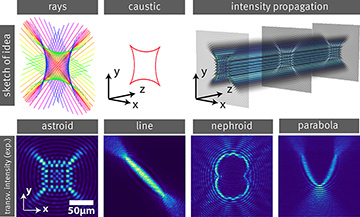 Top: Concept for engineering caustics. The ray distribution corresponding to the edges of a desired caustic structure is embedded into the transverse distribution of a propagation-invariant field. Bottom: Experimentally obtained transverse profiles, showing an astroid caustic, a line, a nephroid and a parabola as high-intensity curves. [Enlarge figure]
Top: Concept for engineering caustics. The ray distribution corresponding to the edges of a desired caustic structure is embedded into the transverse distribution of a propagation-invariant field. Bottom: Experimentally obtained transverse profiles, showing an astroid caustic, a line, a nephroid and a parabola as high-intensity curves. [Enlarge figure]
Caustics—envelopes of light rays reflected or refracted by a curved surface or object, defining a boundary of concentrated intensity—show up in contexts ranging from rainbows and water surfaces to light refracted through drinking glasses. Beneath their beauty, caustics exhibit intensity singularities and can be classified into complex families. Despite their attractive propagation features, including curved, accelerating and superfocusing light, caustics have rarely been artificially generated or exploited as basic entities for structured-light fabrication.1
A particularly interesting class of transversely structured light consists of so-called propagation-invariant or nondiffracting beams, which have a stationary transverse intensity distribution during propagation that is connected with robust and self-healing features. These beams have revolutionized nanoscale material processing with ultrafast lasers, including cutting and channel drilling with high aspect ratios.2 Their robust propagation can reduce beam distortions and minimize manufacturing imperfections.
Among propagation-invariant beams, Bessel and Airy beams are prominent basic representatives of caustics. Caustic features are the reason for the high-intensity concentration in the transverse plane that make these beams well suited for material machining, and their robust and self-healing features have considerably improved applications like optical light-sheet microscopy and 3D trapping. Future advances of these applications, however, require the possibility to arbitrarily structure and control propagation-invariant light shapes with high intensity gradients.3,4 Unfortunately, however, most caustic beams are not naturally nondiffracting.
To fulfill this need, we recently developed a general approach to design, customize and fabricate structured caustic light with arbitrary transverse shapes.5 Our approach uses a smart beam design that advantageously combines the high-intensity features of sharp caustic boundaries with propagation invariance. We have demonstrated various propagation-invariant shapes such as lines, parabolas, or astroids, but also complex shapes like letters. These intensity structures are robust under perturbation, which could make them attractive for secure high-dimensional quantum communication.
Our approach generalizes caustic light from a small subset of naturally occurring beams to a complete set of tailored, propagation-invariant structures with intensities concentrated around any desired edge curve. It satisfies the need for customized high-intensity distributions in all fields of wave physics, including continuous-wave or pulsed light, electron beams, acoustic or elastic waves and many others, and offers promising prospects for advanced, high-resolution nanofabrication processes with complex shapes and controlled energy deposition.
Researchers
Cornelia Denz and Alessandro Zannotti, University of Münster, Münster, Germany
Miguel A. Alonso, Aix Marseille University, CNRS, Centrale Marseille, Institut Fresnel, Marseille, France, and University of Rochester, Rochester, NY, USA
Mark R. Dennis, University of Birmingham, Birmingham, U.K., and University of Bristol, Bristol, U.K.
References
1. H. Rubinstein-Dunlop et al. J. Opt. 19, 013001 (2017).
2. F. Courvoisier et al. Opt. Laser Technol. 80, 125 (2016).
3. F.O. Fahrbach et al. Nat. Photon. 4, 780 (2010).
4. K. Dholakia and T. Čižmár. Nat. Photon. 5, 335 (2011).
5. A. Zannotti et al. Nat. Comms. 11, 3597 (2020).

